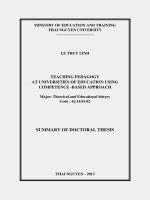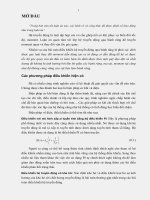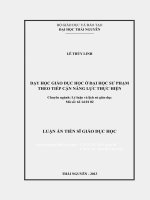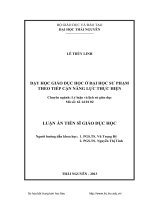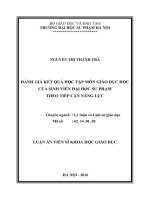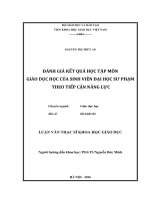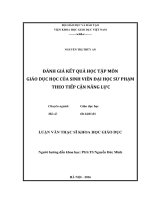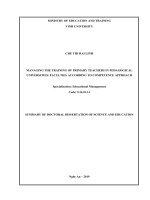dạy học giáo dục học ở đại học sư phạm theo tiếp cận năng lực thực hiện bản tóm tắt tiếng anh
Bạn đang xem bản rút gọn của tài liệu. Xem và tải ngay bản đầy đủ của tài liệu tại đây (471.26 KB, 27 trang )
MINISTRY OF EDUCATION AND TRAINING
THAI NGUYEN UNIVERSITY
–––––––––––––––––––
LE THUY LINH
TEACHING PEDAGOGY
AT UNIVERSITIES OF EDUCATION USING
COMPETENCE -BASED APPROACH
Major: Theorical and Educational history
Code : 62.14.01.02
SUMMARY OF DOCTORAL THESIS
THAI NGUYEN - 2013
The thesis was conducted at:
University of Education - Thai Nguyen University
Supervisors: 1. Assoc. Prof. Dr VU TRONG RY
2. Assoc. Prof. Dr NGUYEN THI TINH
Criticizers:
1:
2:
3:
The thesis will be approved School committee at University of
Education - Thai Nguyen University
At date month year 2013
The thesis can be found at: Vietnam National Library
Thai Nguyen University Library
1
INTRODUCTION
1. The reasons for choosing topic
1.1. The era of economy, knowledge and international integration
have put education system in general and higher education system in
particular in fundamental changes to maintain a key position in
ensuring quality of human resources training for the country. Higher
education training helps students shape and develop capacity in real
life and actual context. Thus, graduate students should quickly
integrate, adapt and meet the demands of practical career.
1.2. Competence - based approach in education is interested by
many educational researchers as the theoretical system on Education
and Training of many countries in the world have confirmed that this
approach becomes a guarantee for higher education in terms of
training high-quality human resources to promote the society
development.
1.3. The research findings report on: “Actual status of training
secondary teacher” concluded that general quality of pedagogic
students currently is not good enough to meet all the requirements of
professional capacity standards and pedagogical training reality. The
subjects on pedagogical skills (especially education studies and
teaching theoretical background) are characteristic of the training
program in most pedagogical universities but they neither meet the
duration need nor have direct impact on shaping teaching and
educational capacity.
1.4. With the above insights, we do hope to apply competence-
based approach in teaching Pedagogy - an important professional
teaching skill subject expressing typical and unique identification of
the pedagogical university. This will be expected to be a promising
research direction which contributes to narrow the gap between on-
the-job training and performance, theory and practice in teacher
training at pedagogical universities.
Basing on above theoretical and practical backgrounds, we would
like to choose the research title: “Teaching pedagogy at Universities
of Education using competence-based approach”.
2. Research objectives
The research will design the pedagogy teaching procedure at the
Universities of Education applying competence - based approach
2
with the aim of improving the quality of teaching and teacher
training of Education Universities, enriching theoretical system of
pedagogy teaching.
3. The subject and object of study:
3.1. The object of study: the process of teaching pedagogy at
Universities of Education
3.2. The subject of study: the process of pedagogy at Universities
of Education using competence - based approach
4. Hypothesis
The formation of competence - based approach in teaching
profession among students has close relationships with the process of
teaching Pedagogy. As the procedure of teaching pedagogy designed
under competence-based approach is feasible, it will help to shape
better teaching profession capacity in students’ mind, contributing to
improve the quality of teacher training.
5. Research Tasks
5.1. Research theoretical backgrounds of teaching Pedagogy at
Universities of Education using competence-based approach.
5.2. Survey and evaluate the situation of employing competence-
based approach in teaching Pedagogy at the University of Education.
5.3. Design the procedure of teaching Pedagogy at Universities of
Education using competence-based approach.
5.4. Conduct pedagogical experiments to test outcomes of
teaching Pedagogy using competence-based approach and assess its
impact on shaping teaching competence among students and the
quality of teaching Pedagogy.
6. Limitation of the study
- In the dissertation, the procedure of teaching Pedagogy at
University of Education is employing competence-based approach
with specific instructions for lecturers to apply to their own teaching
activities design.
- The design of Pedagogy teaching sample activities principles in
the dissertation consists of teaching principles, teaching methods and
forms of teaching organization.
- The survey and assessment of the teaching situation is conducted
in 5 locations: Thai Nguyen University of Education, Xuan Hoa
University of Education, Faculty of Education - Hong Duc
3
University, Faculty of Education - Can Tho University and Vinh
University of Education.
- The experimental contents were conducted on students of Thai
Nguyen University of Education.
7. Research Methods
7.1. Methodology
(1). System-based approach. (2). Practice-based approach. (3)
outcome-based approach: implementation capacity
7.2. Specific research methods.
7.2.1. Theory research methods to construct theoretical
backgrounds for the research problem.
7.2.2. Practical research methods to collect information on the
situation of employing competence-based approach in teaching
Pedagogy and results of Pedagogical experiments.
7.2.3 The complementary methods: mathematical statistics were
used to analyze quantitative and qualitative of the research results.
8. The protection arguments
Competence-based approach motivates Pedagogy teaching at
Universities of Education to perform better results, contributing to
make the training of teachers at pedagogical universities to meet the
requirements of social practices for teaching profession. Pedagogy
teaching at Universities of Education on competence-based approach
requires the teaching process to carry out the survey of
implementation competence, determine implementation competence
standards, define program objectives and program design, training
and ultimately evaluate competence-based approach standard.
9. New contributions of the thesis
9.1. In theory
- The study has expanded teaching theories on competence-based
approach and clarified some new theoretical issues such as the
relationship between competence-based approach and "learning
outcomes", teaching on competence-based approach to train teachers,
teaching Pedagogy on competence-based approach.
- The study has also defined teaching processes on competence-
based approach at training program and course level.
- The study identified the principles and design of the teaching
processes on competence-based approach with specific steps which
4
clearly described goals, and how to implement and conditional
execution.
9.2. In practice
- Results of the survey helped to identify and assess the status of
Pedagogy teaching context at Universities of Education from
competence-based approach angle.
- The results of pedagogical experiments have confirmed the
feasibility of the process of teaching pedagogy using competence-
based approach
- These results are helpful in designing illustrated lesson plans to
guide teachers in their teaching process using competence-based
approach.
10. The structure of the dissertation
The dissertation consists of four chapters apart from the
introduction, conclusion, list of references and appendix.
CHAPTER I
THEORETICAL BACKGROUND OF TEACHING
PEDAGOGY AT UNIVERSITIES OF EDUCATION ON
COMPETENCED-BASED APPROACH
1.1. Overview of studies on teaching using competence-based
approach and pedagogy teaching
*As can be seen from the overview of studies on pedagogy
teaching using competence-based approach, we have some
conclusions:
(1) Competence-based approach training is not a new method in
the world, but has just been applied in Viet Nam in terms of
vocational training. The research on this approach is still limited and
not systematic. The advantages of competence-based approach
training should be applied more widely.
(2) Applying teaching theories on competence-based approach to
pedagogy teaching at Universities of Education can be taken as a
quite new problem, thus the study on teaching pedagogy at
Universities of Education using competence-based approach is a new
direction, contributing to improve the effectiveness of teaching
professional subjects.
5
During this research, we have studied, inherited, and collated with
many theses and data from the above mentioned studies.
1.2. The nature of the teaching process at universities:
Teaching process at universities is the process of vocational
training at a high level to train the future professionals in a certain
occupational field. This process can be considered as a dynamic
balance system of three most important basic elements including
scientific knowledge, teaching and learning activities which interact,
penetrate and regulate one another to perform the same task of
teaching and learning, to shape and develop learners’ personality
with the aim of satisfying the demand of the socio-economic
development in the occupational fields at each particular stage.
At tertiary education, lecturers not only convey knowledge, but
more importantly the organizers of awareness and scientific research
activities to help students develop their own potentials and learn in a
creative way to dominate scientific knowledge.
1.3. Competence-based approach teaching
1.3.1. Capacity and competency
1.3.1.1. Capacity
Capacity is seen as the potential qualities of an individual and the
demands of the job to perform the given tasks successfully. Capacity
is taken as a set of knowledge, skills and attitudes and other personal
qualities (motivation, characteristics, self-identity, desires to perform
) that is essential and important in the formation of the output
products.
1.3.1.2. Competency
Inheriting and developing the previous studies and authors, the
concept “competency” in the research direction of this dissertation is
“comprised of the elements of knowledge, professional skills and
attitudes to ensure that all performers practice their work effectively
according to the learning outcomes standard in certain situations or
occupational tasks. In particular, the skill is an important element of
competency”.
- Competency can be recognized through the following
characteristics:
(+) is the knowledge, skills, attitudes and necessary principles of
workers to perform the entire or some contents of specific
professional employees.
6
(+) is demonstrated to meet the requirements of the learning
outcomes (the standard requires professional practice, but is not the
standard of training).
(+) the performance must be assessed and determined.
In fact, the concept of capacity and competency is just the
different statements of one problem. Capacity emphasizes the ability
to perform, which means learners must “know to do, not only know to
understand”, and “performance” here is associated with knowledge
and skills rather than performing mechanically. Competency is the
same, but the concept “must know and must perform effectively”
here should be associated with certain occupational tasks.
1.3.2. Competence-based approach
The teaching tendency on competence-based approach has been
formed and widely-applied in many countries around the world. The
name of this approach may be different, but the term is commonly
used as competency - based training.
- Paprock pointed out 5 basic characteristics of this approach:
(1) Competence-based approach relies on learner-centered
ideology. (2) Competence-based approach meets the demands of
professional practice.
(3) Competence-based approach has orientation to human’s
realistic life.
(4) Competence-based approach expresses the view of flexible
and dynamic training and teaching.
(5) Competence-based approach allows us to identify the capacity
standards which are needed to shape in leaners explicitly.
- With the above characteristics, competence-based approach
teaching has some advantages:
(1) Allow to personalize learning process. On this model, learners
will self-supplement gaps in knowledge and skills to perform their
own specific tasks.
(2) Output orientation to regulate the teaching and learning
activities.
(3) Create the flexibility to achieve outputs in accordance with
pace and cognitive characteristics of individual learners.
(4) Provide favorable conditions in determining the outcomes of
teaching process through a clear standard evaluation system.
7
1.3.3. Competence-based approach and “learning outcomes”
1.3.3.1. The relationship between “competency” and “learning
outcomes” in competence-based approach teaching.
Learning outcomes is a description of what students should learn,
know or do after graduation. According to competence-based
approach, learning outcomes is a description of the competencies
system including corresponding levels of proficiency in the use of
knowledge, skills and attitudes to solve the occupational practical
tasks that can now happen in the future. (To distinguish and facilitate
the text presentation, learning outcomes on competence-based
approach is referred to as competency-based standard)
1.3.3.2. The steps to determine competence-based standard:
- Survey of the necessary competencies of employees
- Generalizing, arranging capacities into a certain standard system.
With this approach, the competence-based standard of training
program is built on 4 levels.
Level 1 (X) consists of the necessary knowledge and skills to
shape 4 core capacities (advanced capacity):
1. Knowledge and reasoning methods.
2. The professional skills, personal skills and attitude.
3. The communication skills: teamwork and communication.
4. Capacity of recognition, design, implementation and operation
in the context of business and society.
Level 2 (XX) divides knowledge, skills, attitudes and core
capacities into specific contents which reflect practice and research
capacity.
Level 3 (XXX) and level 4 (XXXX) are determined in detail level
and these levels are needed for the transition from the high-level
goals into learning outcomes which can be taught and evaluated.
1.3.3.3. The role of competence-based standard in teaching
process on competence-based approach.
(1) Training program design orientation on competence-based
approach
(2) Subjects design orientation on competence-based approach
(3) Orientation to organize teaching activities on competence-
based approach
(4) Orientation to assess the learning outcomes on competence-
based approach.
8
1.3.4. Competence-based approach in the process of teacher training
1.3.4.1. Survey and describe the necessary capacities of teachers
In the present social context, the secondary teachers need to:
- Detect characteristics of educational objects, have ability to
detect, apply contents of the course in reality.
- Design organization and evaluation plans for teaching and
education activities.
- To implement teaching, education, test and evaluation activities.
- Test and evaluation results in teaching and education process are
utilized to adjust education teaching and education plan.
- Self-assess to constantly improve the teachers’ personalities to
meet the requirement of the society.
1.3.4.2. Competence-based standard determination of teacher training
program
- Detection capacity (identify characteristics of educational
objects, educational environment characteristics, actual relation
capacity of the course content)
- Design capacity (design specific, detailed and feasible teaching
goals system, plans for teaching and other educational activities,
design evaluation plan, design a rich, diverse and attractive learning
resource).
- Performance capacity (plan implementation process, implement
the teaching plan and educational plan, apply the principles, methods
and forms of educational organization)
- Improvement Capacity (self-assessment, self-learning, self-study
and self-discipline, identify and resolve issues that arise in
educational practice, apply assessment results to adjust teaching and
learning activities and assess improvement and career development).
1.3.4.3. Design teacher training program using competence-based
approach.
Designing training program is an important work which requires
intellectual and great efforts of many lecturers from different sectors
and expertise. In this dissertation frame work, we do not go deep into
the construction of training programs, but only refer to curriculum of
some universities as a basis for determining the correlation between
pedagogy subjects with other subjects.
9
1.4. Teaching Pedagogy using competence-based approach
1.4.1. The role and task of the Pedagogy subject in education
programs at universities of education
Pedagogy not only equips pedagogical students with knowledge
as a theoretical background for their future work of teaching and
education but also gradually shape them teaching skills, especially
solving skills arising in teaching and education activities.
Moreover, Pedagogy plays an important role in shaping the
professional ethics quality of teachers such as love for their jobs
and children and other qualities.
1.4.2. Types of teaching organization using competence-based
approach
Action-oriented teaching, teaching under contract, project-based
teaching, micro teaching prevail in the competence-based approach
teaching.
CHAPTER 2
PEDAGOGY TEACHING SITUATION AT UNIVERSITIES
OF EDUCATION FROM THE PERSPECTIVE OF
COMPETENCE-BASED APPROACH
2.1. Some common problems on surveying the pedagogy teaching
situation at Universities of education from the perspective of
competence-based approach.
We surveyed 50 pedagogy lecturers and 500 students who studied
pedagogy as a practical basis for teaching pedagogy on competence-
based approach.
2.2. Survey results
2.2.1. Lecturers’ awareness of the pedagogy and teaching this
subject at Universities of Education
2.2.2. Lecturers’ awareness of teaching pedagogy on competence-
based approach
Lecturers have full awareness of the role of Pedagogy subject at
Universities of Education and understand that this effectively
organized subject will contribute to improve the quality of teacher
training at Universities of Education.
10
However, perceptions of lecturers on pedagogy teaching theories
from perspective of competence-based approach are not deep
enough. In particular:
- The majority of teachers have not shown all the typical
characteristics of the competence-based approach teaching.
- The advantages of the competence-based approach teaching
were not given high appreciation compared to other approaches.
- The competence-based approach teaching is necessary to “form
capacity to meet the requirements of teaching” and is evaluated on a
par with “promoting positive, proactive and creative characteristics
of learners” (72 %).
Finding the causes of this situation, we have known that
competence-based approach training was much explored and applied
in program construction and vocational training organization. There
aren’t any studies of this theory application at Universities of
Education except for several research projects on this application of
theory at technical teacher training schools.
2.2.3. The reality of teaching Pedagogy at University of education
2.3.3.1. the reality of identifying the goal of teaching Pedagogy
- Lectures were well aware of the role of the teaching goal of this
subject during the teaching process.
- In determining the teaching goals, the lecturers initially used
competence-based approach in teaching Pedagogy; however, this
approach was only integrated discretely into each specific lesson. The
determination of the teaching goals that integrated competence-based
approach was only empirical and not organized systematically in
Pedagogy teaching curricula.
2.2.3.2. The reality of designing the teaching content of Pedagogy
(1) Designing Pedagogy teaching curricula
Pedagogy teaching curricula in universities are basically
consistent and focus on the basic knowledge. When investigating the
teaching schedule for each content we see that competence-based
approach has not been represented yet. Most of the teaching time is
for theory. Hours of practice, group discussion focus on clarifying the
views, the perspectives, and the development trends of education.
(2) Designing the teaching content for each particular lesson
The results taken from the survey, the investigation of the
teaching profiles and syllabi reveal that the design of the teaching
11
content for Pedagogy now primarily use the content -based and
objective- based approach. The teaching content which is organized
in rigid orders cannot present the teachers’ missions and
responsibilities in their future professional career.
2.2.3.3. The reality of Pedagogy teaching procedure
The lecturers presented the content in a logical sequence and tried
to encourage the students to be positive, and independent in the
learning process in order to improve the perception quality. However,
it is clear that the teachers didn’t focus on improving the students’
practice skills. Moreover, the investigation indicates that 3 and 4
credits were not enough for the long learning content of Pedagogy.
Also, the overcrowded classes (from 50 to 70 students, even up to
130 students) caused a lot of troubles for the teachers to improve the
students’ vocational skills in the teaching process.
2.2.3.4. The reality of the assessment of Pedagogy study results
Firstly, when designing the course outline the universities and
colleges had to pay much attention to the clear regulations of content
and evaluation, and gave the students the outline of subjects, which
helped them orientate their own learning activities.
Secondly, there was the combination of regular assessment and
summative assessment.
The third point is the assessment contents:
+ For regular assessment, the lecturers often assigned the group
discussions, exercises, practice which required the students to make
effort to apply knowledge when solving problems and to improve
their creative thinking abilities. However, the tasks assigned to the
group or individual are fully theoretical knowledge. Therefore, the
evaluation was mainly aimed at knowledge, thinking skills, and the
theoretical problems rather than the practical issues.
+ The summative assessment mainly focused more on the ability
to memorize and reproduce knowledge.
2.2.4. The reality of the students’ awareness of the role of Pedagogy
and factors affecting the teaching activities
2.2.4.1. The reality of the students’ awareness of the role of Pedagogy
There was not high awareness of the role of Pedagogy among
students . Consequently, many students when interviewed replied that
Pedagogy was a compulsory subject and that they only tried to study
to get good scores because of the higher number of credits.
12
2.2.4.2. Students’ awareness of the factors affecting the learning
interests and learning outcomes of Pedagogy
The effects from the lecturers namely the teaching methods,
teachers’ attitudes towards students in the process of teaching and the
assessment methods have strong influence on the students’ learning
interests and outcomes. Factors such as physical facilities, and
teaching facilities were not appreciated.
2.2.5. The difficulties of the lecturers and students in teaching and
learning Pedagogy using competence- based approach
With regard to the lecturers: the identification of learning goals
was unclear (the teaching goals did not present the orientation role
for their subsequent activities). Criteria for evaluation of the
students’ learning outcomes were not specific. The lecturers did not
use effective methods to better manage the learning process of the
students.
With regard to the students: the students did not actively learn. As
a result, they only learned when requested by the lecturers, and did
not actively study Pedagogy materials to find a suitable learning
methods for themselves.
With regards to the External factors: reference sources for the
course were not plentiful. Facilities were unsuitable for promoting
students’ competency (classes were overcrowded, tables and chairs
were not suitable for flexible movement to form groups in class, ).
There was no favorable learning environment (the forum,
regulations on reporting academic learning progress between the
lecturers and students) to create interactive relationships between
the lecturers and students.
2.2.6. General assessment of the reality of teaching Pedagogy at
University of Education from the perspective of competence-
based approach
Teaching Pedagogy at University of Education is currently not
effective in forming students’ competence because of the following
reasons:
Firstly, the lecturers have not mastered the theoretical system of
teaching from the perspective of competence-based approach,
therefore there is no orientation throughout the teaching process, and
there is no close connection between teaching objectives, teaching
content, processes of teaching, and assessment of learning results.
13
Secondly, the content is designed basing on the lessons, and periods;
as a consequence, it is difficult for the students to form their own
competence when studying pedagogy. Thirdly, the teachers are not
active in renewing the teaching methods. Finally, condition of
facilities, equipment and real environment for teaching activities of
the lecturers in some universities are weak and not enough.
CHAPTER 3
TEACHING PROCEDURE OF PEDAGOGY AT UNIVERSITY
OF EDUCATION FROM THE PERSPECTIVE OF
COMPETENCE - BASED APPROACH
3.1. Some oriented principles of designing the teaching process of
pedagogy from the perspective of competence-based approach.
Designing the teaching process of pedagogy using competence-
based approach must ensure the systematization, effectiveness and
ensure the unity between theory and practice.
3.2. Teaching procedure of Pedagogy at University of Education
from the perspective of competence-based approach.
3.2.1. Designing the procedure of Pedagogy teaching at the
university using competence-based approach
The teaching procedure using competence-based approach is
subdivided into 2 levels and conducted in the following orders:
At macro level (course level).
Step 1. Analyse the learning outcomes of Universities of
Education using competence-based approach, the standard
competence of Pedagogy and teaching objectives.
Step 2. Design the syllabus of Pedagogy using competence-based
approach.
At micro level (lesson level).
Step 3. Design Pedagogy lessons using competence-based
approach.
Step 4. Organize the process of Pedagogy teaching using
competence-based approach.
Step 5. Test and assess the results of Pedagogy teaching using
competence- based approach.
14
3.2.2. Steps in the process of teaching pedagogy at University of
Education using competence- based approach.
3.2.2.1. Analyse the learning outcomes of Universities of Education
using competence-based approach, the standard competence of
Pedagogy and teaching objectives.
(i) Objectives
Define accurately and clearly the teaching targets system using
competence- based approach.
Identifying the teaching goals appropriately will help:
- Orientate the lecturers to design the syllabus using competence-
based approach, and as a result to guide students to have good
selection, method combination, means and ways of organizing
teaching process to develop the teaching competency for them.
- Determine the goals of assessment, evaluation scales and
evaluation methods, test forms, evaluation of students’ learning
outcomes.
(ii) Steps and methods
- Step 1: define the attainment of the teaching content in
comparison with the standards of the teaching competency of the
training program.
- Step 2: defining the teaching content can form students’ teaching
competency.
- Step 3: define the teaching objectives using competence- based
approach.
- Step 4: Define the standards of teaching competency of
Pedagogy.
(iii). The conditions for the implementation
It is necessary for the university to have the innovative thinking in
the teaching approach employing competence- based approach . This
helps to force to innovate the teaching activities basing on the new
approach to train the teachers to meet the needs of society.
- Departments should agree on objectives, contents, methods and
how to conduct assessment of student learning outcomes utilizing
competence- based approach .
- Instructors must have the capability to design teaching goals
using competence- based approach.
- Teachers must understand the standards of teaching competency
of teacher training programs as well as each specific training major at
15
their school, which identified the new flexible teaching goals to suit
each individual student.
- Students must be aware of their learning responsibilities and
duties. On the basis of the teaching and learning goals that the
teachers give, they have to identify their own learning objectives
correctly and appropriately.
3.2.2.2. Designing course syllabi in a competence-based approach
(i) Objectives
- Course syllabi are designed in order to help lecturers have more
freedom and responsibility in their own teaching plan.
- The contents are designed in a competence-based approach to
provide lecturers with an overview of their teaching plan so as to
form students’ competence.
- Course syllabi are also effective tools in supervising and
administering lecturers’ teaching procedure.
(ii) Steps and methods
It is understood that designing a pedagogy course syllabus in a
competence-based approach is a process of integrating the
competence-based approach of pedagogy into the contents of
teaching. This can be done in two ways:
Defining the aim of forming students’ competence along with
the aim of pedagogy teaching in the current curriculum of teacher’s
training college now.
Adjusting the contents of pedagogy in the competence
standard. By doing this, lecturers can compare and contrast
competence standard with the contents of pedagogy and add some
details to form students’ teaching competency in a complete and
stably.
Designing course syllabi in a competence-based approach has to
follow the steps:
- Step 1: demonstrating contents of pedagogy that can meet the
requirements of competence standard.
- Step 2: defining the objectives of teaching and forming
intergrated teaching aims
- Step 3: designing course syllabus based on the description and
aims of intergrated teaching aims
- Step 4: defining assessment methods
16
(iii). The conditions for the implementation
There should be an agreement on the implementation of pedagogy
among members of the teaching division.
Every lecturer has to adapt their teaching method positively in
order to apply the teaching curriculum effectively.
Every lecturer has to improve his own course designing
competency in order to implement the curriculum that has been
designed.
3.2.2.3. Designing lessons in a competence-based approach
(i) Objectives
- To give details of lecturer’s and students’ teaching and learning
procedure during the course of pedagogy teaching in a competence-
based approach and clarifying what lecturers and students have to do.
- Give specific guidance to lecturers in terms of designing lessons
in a competence-based approach.
- Designing lessons in a competence-based approach helps
lecturers and students find the answer to the questions of what to
teach and what to learn so that there will be the right guidance in
students’ learning process to get their expected results.
(ii) Steps and methods
- Step 1: defining the aims of the lessons
- Step 2: studying documents to decide on the contents of the
lessons
- Step 3: defining the method and the way of teaching
- Step 4: preparing the teaching aids and materials for the lessons
- Step 5: designing lesson plans
(iii). The conditions for the implementation
- University leaders and teaching division have to design and
rearrange the contents of pedagogy in a competence-based approach.
- Lecturers have to master the contents of pedagogy and always
try to improve themselves and their knowledge.
- Lecturers have to accumulate necessary abilities to catch up with
the content of competence-based approach such as designing
competence, controlling competence and self-assessment ability in
the in a competence-based approach.
- Lecturers have to accumulate appropriate teaching competence
in order to catch up with the contents of the teaching in a
competence-based approach.
17
- Lecturers have to design learning cards, assessment cards to suit
each teaching activity and each student.
- Students must have positive attitude towards creative teaching
and learning method. Besides studying present pedagogy
coursebooks, they have to search for information on the internet,
exchange ideas with high school teachers and actively discuss in
order to master the content of the teaching.
3.2.2.4. Organising teaching methods in an competence-based
approach
(i) Objectives
- To create a friendly environment and encourage the cooperation
between lecturers and students and among students.
- Combining various teaching methods and modern teaching aids
in order to sharpen career skill for students of education colleges as
well as modifying one way teaching method which focuses on
providing theories.
- Pay close attention to students’ attitudes and behaviors.
- Providing detailed guidance to lecturers of pedagogy in colleges
so that they know the procedure and steps of carrying out activities
when they teach in competence-based approach.
(ii) Steps and methods
Step 1: Preparing
Step 2: Organizing teaching
(iii). The conditions for the implementation
- Lecturers must have the ability to design, organize and dealing
with teaching situations in order to control successive activities
successfully.
- Lecturers have to design detailed guidebooks to help students
follow the steps of the activities.
- Students have to be aware of the meaning of learning and their
tasks in order to have the right learning attitudes under the guidance
of lecturers.
- The leaders of the university have to provide the best facility
condition. Desks can be detached or joined to be suitable for whole
class work or group work. There must be accessible Wi-Fi in every
classroom so that lecturers and students can update and exchange
information. More course books and reference books should be
18
bought to put in the library. There are many other things to make
teaching and learning effective.
3.2.2.5. Assessment of teaching pedagogy according to the
competence-based approach.
(i). Objectives
- Create a change in assessment process of the subject
“pedagogy.” The assessment criteria are not only based on
knowledge achievement (mainly students’ reproduction levels), but
also based on skill proficiency levels of students.
- Provide teachers with scientific guidelines to correctly assess
students' competence formed during the course of pedagogy.
- For teachers to be able to accurately assess students according to
competence-based approach as a basis to adjust the teaching process
in an appropriate manner.
- Combine teachers’ assessment with students’ self-assessment to
adjust external feedback and internal feedback during teaching.
(ii). Steps and methods
Step 1: Identify assessment standards of pedagogy in accordance
with competence-based approach.
Step 2: Identify tasks/exercises to assess pedagogy in accordance
with competence-based approach.
Step 3: Identify assessment criteria of task complement based on
predefined standards
Step 4: Develop assessment guidelines
(iii). Conditions for implementation
- Teachers have to be equipped with knowledge of teaching
procedures and assessment of the subject pedagogy according to the
competence-based approach.
- Students should have a positive attitude towards learning,
avoiding rote learning for assessment of pedagogy.
- The institution should provide teachers and students with
facilities for them to have time and room in order to carry out skill
assessment.
3.2.2.6. Relationship among steps in the procedure
Steps in the procedure do not stand alone, but they have consistent
and dialectical relationship.
- Identify objectives of pedagogy teaching according to
competence-based approach, which orients the syllabus design,
19
teaching process development and acts as a basis to develop
assessment criteria.
- Designing of the syllabus and lessons of pedagogy is under the
orientation of teaching objectives but it helps to realize the preset
objectives. On the other hand, the teaching content directs the
development of assessment procedure and content of pedagogy.
- Implementation of pedagogy teaching procedures includes
detailed guidelines to carry out the teaching procedures. It specifies
methods to achieve teaching objectives and change what is taught
into knowledge, and skills of students and also includes instructions
for assessment.
- Content, formats and methods of pedagogy assessment should be
based on objectives, contents and implementation according to a
certain procedure. However, assessing correctly and objectively the
teaching results is a reality basis to adjust objectives and content of
pedagogy.
Pedagogy teaching requires a consistent coordination of all steps
in order to get a good result.
CHAPTER 4: EXPERIMENTAL STUDY
4.1. The overview of the experiment
The experiment was carried out to verify the accuracy of the
hypothesis and the possibility of the proposed process.
The teaching process includes two levels, and the ideas of
designing the Pedagogy syllabus at macro level and conducting of the
experimental study at micro level were recommended.
To carry out the experimental study, the purpose, content,
procedure, methods, and evaluation criteria were identified.
4.2. The results and discussion
4.2.1. Analysis of the experimental results
4.2.1.1. Quantative analysis of the experimental results
(1) The results of the first experiment
(1.1) The evaluation of the results of forming the teaching
capacity for students in classes TN-1 and C-1
Step 1: Design the table of distribution frequency and the graph of
convergence frequency of ascending scores
20
Table 4.1. The frequency of scores evaluating students’ teaching
competency in classes TN-1 and C-1- the first evaluation
Groups
Total
number
Scores
1
2
3
4
5
6
7
8
9
10
C-1
35
0
0
0
3
6
9
13
3
1
0
TN-1
35
0
0
0
1
2
4
11
13
4
0
0%
20%
40%
60%
80%
100%
120%
đim
%
TN1
C1
TN1
0%
0%
0%
3%
9%
20%
51%
89%
100%
100%
C1
0%
0%
0%
9%
26%
51%
89%
97%
100%
100%
1
2
3
4
5
6
7
8
9
10
Graph 4.4: The convergence frequency of ascending scores of
TN-1 and C-1 classes
Step 2: Describe the sample’s parameters
Table 4.2:Statistical parameter decsription of the results of
forming the teaching competency after the experiment
First experiment
TN-1
C-1
Mean
7.286
6.286
Standard Error
0.199
0.203
Median
7
6
Mode
8
7
Standard Deviation
1.178
1.202
Sample Variance
1.386
1.445
Step 3: Test the difference of the mean scores between TN-1 and
C-1 (Z-Test: Two Sample for Means)
Z of TN-1 = 3.51 > Z Critical = 1,96. Therefore, the H0
hypothesis is rejected, but the H1 hypothesis is accepted. As a
consequence, the significant difference of the mean scores of the
Experimental and the Controlled Group is scientifically meaningful.
Step 4: Analyze of the variances of the Experimental and
Controlled Group.
21
The ANOVA shows that F of TN-1 = 12.3590 is higher than F crit
= 3.9819. Thus, the HA hypothesis is rejected and HB hypothesis is
accepted, that means the teaching process employing the
competence-based approach in TN-1 (Experimental Group) is better
than C-1 (Controlled Group) which does not use the competence -
based approach.
(1.2) Evaluation of students’ learning results in TN-1 and C-1
The results of the experiment reveals that “ the use of the teaching
process from the perspective of competence -based approach has
better influence on the students’ learning results in TN-1
(Experimental Group) than in C -1 (Controlled Group) which does
not use the competence -based approach
(1.3) Evaluation of the correlation between the results of the
learning and the teaching competency in TN-1 and C-1
- The scores are closely correlated.
(2) The results of the second experiment
After the first experiment, the teaching process of Pedagogy is
evaluated so that the conductors can get better results in the second
experiment.
Results in the second experiment show that the hypothesis given
is accurate.
(3) Comparison of the results of the first and second experiment
The students’teaching competency and learning results in the
second experiment are higher than those in the first experiment. This
reveals that the innovation in the teaching process is very necessary
and possible.
4.2.1.2. Qualitative analysis of the experimental results
* The lecturers’ view points:
100% of the lecturers consider that the teaching process is very
appropriate, quite appropriate, very feasible, quite feasible. Most of
the lecturers rank level 1. This partly confirms the process can be
applied in practice.
* The students’ view points:
Firstly, collect individual student evaluation forms when
participating in group work (for each individual student) and group
evaluation forms (for self- evaluation group)
22
Secondly, from the observation it is clear that the students in TN
class are more confident when having presentation. They can explain
clearly the content, the purpose of the products and the requirement
for the lecturers during the teaching process.
Thirdly, the product research shows that the students in TN Group
have better products than C Group in reference to both appearance
and quality. Also, C Group submit their product late.
4.2.2. Some discussions
The results of the experimental study confirm that:
- The teaching process using competence-based approach is
feasible, as it is indicated that the lecturers can implement the
teaching procedure easily.
The process is efficient, as shown in the formation of the students’
teaching competence and learning outcomes.
During the study we found that the results of the experimental
study are just the first step. To ensure the stability and development
of the achievement, the process of teaching Pedagogy employing
Competence-based approach should be further studied and
implemented on a large scale, this will bring enormous value in the
teaching process of Pedagogy in particular and in the teacher training
process at Universities of Education in general.
CONCLUSION AND RECOMMENDATIONS
1. Conclusion
First: Following the common development trend, it is necessary
to innovate in pedagogy teaching at universities of education
according to the competence-based approach, which helps to meet
the higher and higher requirement of the society for teachers’
professional skills.
Second: Teaching based on the competence - based approach is
the movement and development of factors in the structure of teaching
process, in which the competence-based standard is the basis to
design, carry out and assess the teaching process. The theoretical
analysis proves that: It is possible to carry out the process of teaching
pedagogy following the competence-based approach. This improves
the effectiveness of teaching process, which makes pedagogy take its
role as a profession-oriented subject in an education institution.
23
Third: In fact, currently teaching pedagogy in universities of
education mainly focuses on theories and does not pay attention to
the formation of teaching competence of students. There are many
objectives and subjective reasons but it cannot be denied that one of
the major reasons is that teachers have not been equipped with the
theory to instruct the process of teaching in a way which improves
students’ professional competence.
Fourth: To solve this problem, it is required to use the process of
teaching pedagogy including: Identify objectives, design content;
develop the teaching process and change assessment methods. Each
step in the procedure has been made clearly in terms of objectives,
content, methods and conditions for implementation, so it could
provide a clear guideline for teachers to teach pedagogy according to
the competence-based approach.
Fifth: The empirical study initially showed the feasibility and
efficiency of the above procedure.
2. Recommendation
First: Administration staff at universities of education
- Should be aware of the importance of pedagogy in education
institutions.
- Provide teachers and students with good conditions to be able to
take the control in terms of time, increase practice time during the
course.
Second: Teachers who are in charge of pedagogy
- Should be deeply aware that their teaching activities make a
large contribution to the quality of teacher training in education
universities; have desire and strong will to overcome difficulties in
psychology and reality to change the teaching activities from pure
theories into competence teaching.
- Should research carefully the course and characteristics of
students attending the university that they works in order to adjust
objectives, content of teaching in an appropriate way.
- Should always encourage and strengthen students' activeness
and creativity; create a collaborative learning environment between
students and teachers, between students and students; at the same
time, improve their major role and be available to help students if
needed.
